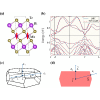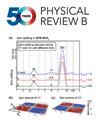圆偏振光照射铁磁 MnBi2Te4:一种可能的理想韦尔半金属
IF 3.7
2区 物理与天体物理
Q1 Physics and Astronomy
引用次数: 0
摘要
光与非三维能带拓扑之间的相互作用允许精确操纵拓扑量子态,这引起了凝聚态物理学的浓厚兴趣。在这项工作中,我们利用第一原理计算,研究了铁磁(FM)MnBi2Te4 在圆偏振光(CPL)照射下的拓扑转变。我们发现,在没有时间反转对称性的体系中,MnBi2Te4 能以最少的韦尔点数量(即两个韦尔点(WPs))从调频绝缘体转变为韦尔半金属。更重要的是,在具有平面外易磁化轴的调频锰铋2Te4中,我们发现当光照强度增加时,WP的带散从II型演变为III型,并最终演变为I型。此外,我们还发现韦尔半金属相的费米弧特征轮廓对光强变化非常敏感,这使得在实验中可以有效地操纵调频锰铋碲的费米弧长度。此外,对于具有面内易磁化轴的调频锰铋碲,该体系在 CPL 照射下会成为 I 型韦尔半金属。我们的研究结果表明,CPL 照射下的调频锰硼碲(FM MnBi2Te4)具有可控的能带色散、费米弧长度和最少的 WPs 数量,是研究具有独特能带色散的韦尔半金属中新型输运现象的理想平台。本文章由计算机程序翻译,如有差异,请以英文原文为准。

Circularly polarized light irradiated ferromagnetic MnBi2Te4: A possible ideal Weyl semimetal
The interaction between light and nontrivial energy band topology allows for the precise manipulation of topological quantum states, which has attracted intensive interest in condensed-matter physics. In this work, using first-principles calculations, we studied the topological transition of ferromagnetic (FM) upon irradiation with circularly polarized light (CPL). We revealed that the can be driven from an FM insulator to a Weyl semimetal with a minimum number of Weyl points, i.e., two Weyl points (WPs) in systems without time-reversal symmetry. More importantly, in FM with an out-of-plane easy magnetization axis, we found that the band dispersion of the WP evolves from type-II to type-III and finally to type-I when the light intensity increases. Moreover, we show that the profile of the characteristic Fermi arc of the Weyl semimetal phase is sensitive to changes in light intensity, which enables efficient manipulation of the Fermi arc length of FM in experiments. In addition, for FM with an in-plane easy magnetization axis, the system becomes a type-I Weyl semimetal under CPL irradiation. With controllable band dispersion, the length of the Fermi arc, and a minimum number of WPs, our results indicate that CPL-irradiated FM is an ideal platform for the study of novel transport phenomena in Weyl semimetals with distinct band dispersion.
求助全文
通过发布文献求助,成功后即可免费获取论文全文。
去求助
来源期刊

Physical Review B
物理-物理:凝聚态物理
CiteScore
6.70
自引率
32.40%
发文量
0
审稿时长
3.0 months
期刊介绍:
Physical Review B (PRB) is the world’s largest dedicated physics journal, publishing approximately 100 new, high-quality papers each week. The most highly cited journal in condensed matter physics, PRB provides outstanding depth and breadth of coverage, combined with unrivaled context and background for ongoing research by scientists worldwide.
PRB covers the full range of condensed matter, materials physics, and related subfields, including:
-Structure and phase transitions
-Ferroelectrics and multiferroics
-Disordered systems and alloys
-Magnetism
-Superconductivity
-Electronic structure, photonics, and metamaterials
-Semiconductors and mesoscopic systems
-Surfaces, nanoscience, and two-dimensional materials
-Topological states of matter
 求助内容:
求助内容: 应助结果提醒方式:
应助结果提醒方式:


